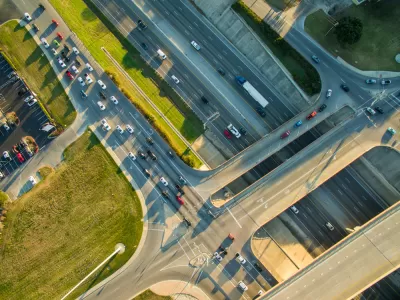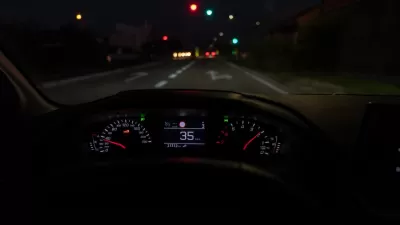Interstate speed limits can have an impact beyond their own lanes.

A new study reveals that increased speed limits on interstate freeways have a rippling effect, raising the number of speeding-related crashes in adjacent neighborhoods.
As Kea Wilson explains in Streetsblog USA, “In an analysis of three U.S. highway segments whose maximum speeds were increased at some point in the last decade — I-85 in Georgia, I-84 in Oregon and I-75 and I-69 in Michigan — researchers found that all reported significant new "clusters" of speeding-related crashes within a one-mile radius of the interstate.”
The findings belie the popular belief that interstate speeds don’t affect people traveling on other roads — including pedestrians and cyclists who never enter freeways. According to Dr. C.Y. David Yang, president and executive director of the AAA Foundation for Traffic Safety, “similarly to the ‘distraction hangover’ that drivers experience even after they stop using a cell phone behind the wheel, motorists don't immediately register just how quickly they need to slow down after they exit the interstate — especially when local roads themselves are designed like highways where it's perfectly fine to go fast.”
Wilson points out that interstate routes and speed limits are controlled at the state level, giving local communities little say in the process. “While Yang stops short of saying that speed limits should never be raised on the highway, he says it's critical that stakeholders like state, county, and city departments of transportation communicate in advance of those increases, so the locals can take action to slow drivers down, like modifying road designs.”
FULL STORY: Study: When Speed Limits Rise on Interstates, So Do Crash Hot Spots on Nearby Roads

Alabama: Trump Terminates Settlements for Black Communities Harmed By Raw Sewage
Trump deemed the landmark civil rights agreement “illegal DEI and environmental justice policy.”

Planetizen Federal Action Tracker
A weekly monitor of how Trump’s orders and actions are impacting planners and planning in America.

The 120 Year Old Tiny Home Villages That Sheltered San Francisco’s Earthquake Refugees
More than a century ago, San Francisco mobilized to house thousands of residents displaced by the 1906 earthquake. Could their strategy offer a model for the present?

Opinion: California’s SB 79 Would Improve Housing Affordability and Transit Access
A proposed bill would legalize transit-oriented development statewide.

Record Temperatures Prompt Push for Environmental Justice Bills
Nevada legislators are proposing laws that would mandate heat mitigation measures to protect residents from the impacts of extreme heat.

Downtown Pittsburgh Set to Gain 1,300 New Housing Units
Pittsburgh’s office buildings, many of which date back to the early 20th century, are prime candidates for conversion to housing.
Urban Design for Planners 1: Software Tools
This six-course series explores essential urban design concepts using open source software and equips planners with the tools they need to participate fully in the urban design process.
Planning for Universal Design
Learn the tools for implementing Universal Design in planning regulations.
Clanton & Associates, Inc.
Jessamine County Fiscal Court
Institute for Housing and Urban Development Studies (IHS)
City of Grandview
Harvard GSD Executive Education
Toledo-Lucas County Plan Commissions
Salt Lake City
NYU Wagner Graduate School of Public Service





























